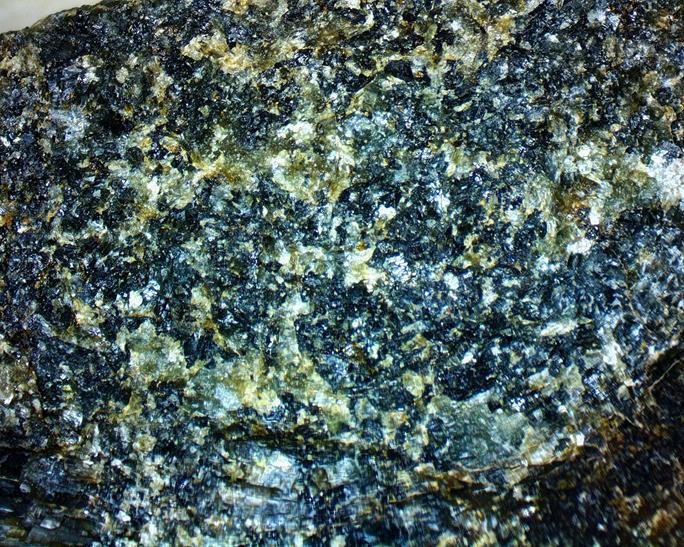Gabbroic rocks or gabbroids are coarse-grained, dark-colored mafic rocks. A mafic rock is one rich in iron and magnesium.
These rocks are mostly plutonic or intrusive, i.e., solidify inside the Earth’s crust. However, some solidify in thick lavas are in the interior part, making them extrusive.
In both scenarios, cooling is very slow, allowing the formation of coarse-grained texture. Additionally, they can have other textures like pegmatitic, porphyritic, or orbicular.

What makes a rock gabbroic?
Gabbroic rocks are basic rocks low in silica, usually 45-52 wt.%. These rocks are high in iron, calcium, and magnesium oxides and lower in sodium and potassium oxides.
Secondly, they are mafic rocks with mostly calcic-plagioclase and augite, a clinopyroxene. The plagioclase has more than 50 mol.% anorthite and is often labradorite to bytownite.
Additionally, these rocks may have other minerals like olivine, hornblende, calcium-poor pyroxenes like enstatite and pigeonite, alkali feldspar, quartz, feldspathoids, hornblende, and less often biotite.
It is a good idea to know that pigeonite is a clinopyroxene and enstatite is an orthopyroxene.
Thirdly, on the QAPF classification, gabbroic rocks are coarse-grained rocks in which quartz accounts for up to 20% and feldspathoids 10% of total QAPF content by volume with calcic plagioclase at least 65% of the total feldspars.
Let us look at the gabbroic rocks
1. Gabbro and subtypes
Gabbro is one of the gabbroic rocks in which quartz is less than 5% of the QAPF content by volume, and plagioclase is 90% of the total feldspar.
Gabbro is further divided depending on plagioclase, pyroxene, clinopyroxene, orthopyroxene, olivine, and hornblende into:
i. Endmembers like:
a). Normal gabbro
Normal gabbro (sensu stricto gabbro) consists of essentially plagioclase and clinopyroxene (augite) with olivine, hornblende, and orthopyroxene, each less than 5%.
b). Norite
Norite is a coarse-grained, dark-colored rock with almost entirely plagioclase and orthopyroxene with clinopyroxene, hornblende, and olivine, each less than 5%.
Other common minerals are biotite and cordierite. Also, it may have a small amount of alkali feldspar, with ilmenite and quartz as the common accessory minerals.
Lastly, norite occurs commonly in layered intrusions, mostly lopoliths, and sometimes in dike swarms.
c). Troctolite
Troctolite is a coarse-grained, dark-colored rock dominated by plagioclase and olivine with pyroxenes (clinopyroxenes or orthopyroxenes) and olivine, each less than 5%.
This rock is essentially a gabbro depleted of pyroxenes, i.e., augite. It is dark gray with lighter plagioclase and greenish-orange olivine speckles, resembling a trout fish.
d). Hornblende gabbro
It is coarse-grained rock, much like gabbro sensu stricto, but has almost entirely plagioclase and hornblende with pyroxenes and olivine, each below 5%.
ii. Intermediate members
Some of the intermediate members include:
a). Gabbronorite
Gabbronorite is a coarse-grained mafic rock. It comprises gabbro and norite and nearly equal amounts of clinopyroxene and orthopyroxene with olivine less than 5%.
Clinopyroxene is augite, while orthopyroxene is enstatite to bronzite. Other accessory minerals include biotite, hornblende, ilmenite, apatite, and magnetite.
b). Olivine gabbro
Olivine gabbro is a coarse-grained mafic rock with essentially calcic plagioclase and a considerable amount of olivine and pyroxenes, i.e., more than 5% each.
Accessory minerals include hematite, hornblende, biotite, apatite, etc.
c). Orthopyroxene gabbro
This coarse-grained gabbro rock has almost entirely calcic plagioclase and orthopyroxene with clinopyroxenes less than 5%.
2. quartz gabbro
Quartz gabbro is a coarse-grained gabbroic rock in which quartz is 5-20% of the total QAPF content by volume, and plagioclase accounts for over 90% of total feldspars.
Its composition lies between gabbro and tonalite and has mainly calcic plagioclase and augite. Also, it may have alkali feldspar, olivine, biotite, and other pyroxenes.
3. Foid-bearing gabbro
In this coarse-grained mafic rock, feldspathoids account for up to 10% of the total QAPF content, and plagioclase is over 90% of the total feldspars.
When naming it, use the names of the dominant feldspathoids. For instance, you can have analcime-, leucite-, sodalite-, or nepheline-bearing gabbro.
4. Monzogabbro
This coarse-grained intrusive igneous rock has a composition that lies between gabbro and monzonite. It has up to 5% quartz of the QAPF content by volume, and 65-90% of feldspar is plagioclase.
5. Quartz monzogabbro
On the QAPF classification, quartz monzogabbro is a coarse-grained igneous rock in which quartz is between 5 and 25% quartz, with plagioclase accounting for 65-90% of total feldspar.
Its composition lies between quartz gabbro and quartz monzonite.
6. Foid-bearing monzogabbro
Foid-bearing monzogabbro is a coarse-grained, igneous rock defined on the QAPF classification as one with up to 10% foids, with feldspar making up 65-90% of the total feldspar.
When naming this rock, you can replace the word foid with the dominant feldspathoid.
Note: Contrary to what some authors suggest, foid gabbro and foid monzogabbro are not gabbroic rocks. They have more than 10% foids, yet gabbroids have less than 10%.
Alkali and tholeiitic gabbro
Alkali gabbro forms from magmas high in sodium and potassium oxide and low in iron and calcium oxide. These rocks are slightly lower in silica content and have calcium/titanium-rich augite. Also, they have interstitial normative feldspathoids and alkali feldspar but often lack glass.
On the other hand, tholeiitic gabbros are silica-saturated or oversaturated relative alkali oxides. These rocks are higher in silica, the alkali type, and have calcium-poor pyroxenes like pigeonite and enstatite.
Also, they have interstitial normative quartz, and glass is common.
